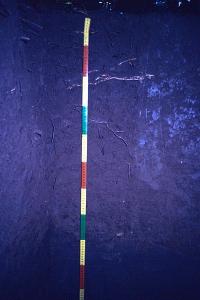Reference soil Ecuador 07: Acrisol
Acrisols occur dominantly in the wetter parts of the tropics and subtropics and the warm temperate regions in relatively young landscapes.
Characteristics
Soils having an argic horizon (a subsurface horizon with distinct higher clay content than the overlying horizon), which has a cation exchange capacity of less than 24 cmolc per kg in some part, either starting within 100 cm from the soil surface, or within 200 cm from the soil surface if the argic horizon is overlain by loamy sand or coarser textures throughout. They have a base saturation (total amount of Ca, Mg, K and Na with respect to the cation exchange capacity) of less than 50 percent in the major part between 25 and 100 cm from the soil surface
Reference soil EC007: Acrisols
Brief description of the soil: deep, well drained, yellowish brown clay. At about 90 cm starts a hard cemented sandy tuff substratum. The parent material consists of two layers. From 0 to 92cm quarternary alluvium, probably mixed with some volcanic ash. From 92cm starts abruptly a very hard layer, consisting of sandy ash, probably transported and deposited by the river. The genesis of the cementation and hardness of this layer is not yet understood. The very hard layer could only be broken with a pick-axe. The hard layer blocks root development and permeability for water is low. No water table has been observed, however it is assumed that excess water runs laterally to depressions. * INIAP station San Carlos trial field has about 350 cocoa varieties. FAO, 1988 Haplic Acrisol USDA, 1990 ?
